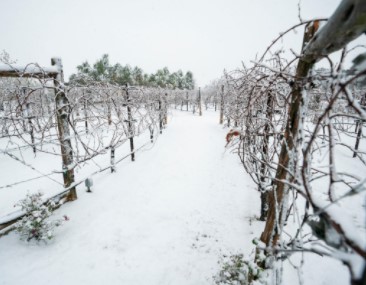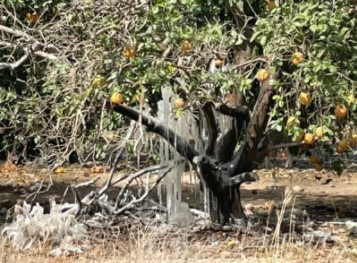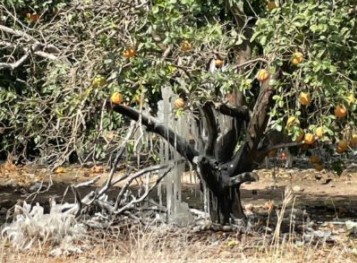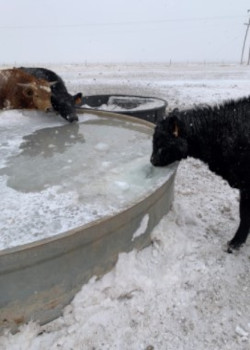By Paul Schattenberg
Winter Storm Uri, which blasted through the entire state of Texas, caused at least $600 million in agricultural losses, according to preliminary data from Texas A&M AgriLife Extension Service agricultural economists.

Snow-covered grapevines.
“A large number of Texas farmers, ranchers and others involved in commercial agriculture and agricultural production were seriously affected by Winter Storm Uri,” said Jeff Hyde, Ph.D., AgriLife Extension director, Bryan-College Station. “Freezing temperatures and ice killed or harmed many of their crops and livestock as well as causing financial hardships and operational setbacks. And the residual costs from the disaster could plague many producers for years to come.”
AgriLife Extension estimates of some of the state’s biggest agricultural losses by commodity were:
— Citrus crops: At least $230 million.
— Livestock: At least $228 million.
— Vegetable crops: At least $150 million.
Another agricultural sector that experienced significant losses was the green industry. AgriLife Extension, in collaboration with the Texas Nursery and Landscape Association, developed and distributed a loss assessment survey to more than 4,000 nursery, greenhouse and other green industry-related businesses requesting input on the type and extent of losses encountered. It will be several weeks before there is sufficient data to provide an assessment of those losses.
How agricultural losses were estimated
“The data we used to determine these agricultural losses came from farmers, ranchers and other commercial producers throughout the state as well as others involved in or supporting production agriculture in Texas,” said Mark Waller, Ph.D., associate head of Texas A&M University’s Department of Agricultural Economics, Bryan-College Station.
Monty Dozier, Ph.D., AgriLife Extension program director for disaster assessment and recovery, said the data related to agricultural losses was acquired through the agency’s extensive statewide network of agents and specialists.
“Our people collaborated with agricultural industry groups and other stakeholders to get the most accurate and up-to-date information available at this time,” Dozier said. “Then the information was assembled and analyzed by agricultural economists and other agricultural experts from Texas A&M AgriLife using a standardized approach.”
Waller said currently the agency can only provide a general range of loss or estimated overall loss for the state’s agricultural sectors.
“There are still many as yet unknown and lingering effects of Winter Storm Uri,” he said. “What we can say is these figures are conservative and we expect more losses as a long-term effect of this disaster.”
The citrus situation
“The Texas agricultural sector that suffered one of biggest overall losses from Winter Storm Uri was the citrus industry,” said Luis Ribera, Ph.D., AgriLife Extension economist, Bryan-College Station.

Winter Storm Uri left iced-over grapefruit tree in Rio Grande Valley.
Ribera said citrus producers in the Rio Grande Valley lost virtually all of their Valencia orange crop and more than 60% of their grapefruit crop.
“Even more citrus crops would have been lost had many not been harvested before the storm,” he said.
Ribera said the AgriLife Extension estimate for citrus losses came out to around $230 million and was based primarily on losses in the Rio Grande Valley during the storm.
“That estimate also included longer-term losses from next year’s crops, but it did not include the cost of citrus plants that could die or remain badly damaged by the freeze and have to be replaced,” he said. “If they must be replaced, it will be several years before those new citrus trees are able to bear fruit, so the losses could be much more.”
Juan Anciso, AgriLife Extension horticulturist based at the Texas A&M AgriLife Research and Extension Center in Weslaco, said about 200 acres of lemons and limes produced in South Texas were destroyed completely because those plants were more sensitive to cold weather than other types of citrus.
“If those producers choose to replant, it will be three to five years before those new plants will begin to yield fruit,” Anciso said.
Ribera said while the effects of the storm likely will impact grapefruit availability and prices in the future, it probably won’t have a significant impact on orange prices due to large supplies available from Florida and California.
Other crops blasted by freezing weather
Along with their citrus losses, Rio Grande Valley and other South Texas producers also suffered some significant losses in terms of both cold- and warm-season vegetable crops.
Cool-season vegetable crops like leafy greens, beets, cabbage and celery were lost. There were also warm-season crops of potatoes and watermelons planted for early harvest devastated by the freezing weather.
Samuel Zapata, Ph.D., AgriLife Extension economist, Weslaco, said there were notable vegetable losses throughout the area.
“The main vegetable crop damage we saw was to onions, then to leafy greens, including spinach, collard greens and kale, and then to watermelons,” he said.
Zapata said a low estimate based on losses from sales of those and other vegetable crops in that part of the state alone would be at least $150 million.
“Working with the Texas International Produce Association, we estimated a loss of more than $42 million in sales of onions, more than $27 million in sales of leafy greens, more than $20 million in sales of watermelons and more than $15 million in sales of cabbage,” he said. “We also estimated at least another $42 million in additional vegetable and herb sales losses for these large vegetable crop-producing areas. Of course, producers lost vegetable crops in other areas of the state as well, so we determined the $150 million figure to be a minimum.”
Zapata said sugarcane is another major South Texas crop that took a hit from Winter Storm Uri.
“According to the sugar industry, minor damage is expected to the 2020-2012 sugarcane crop given that most of it was already harvested before Uri,” he said “However, a significant drop in yields is expected for next year’s crop as pretty much all cane plants were destroyed and producers will have to start over. It is too early to know the magnitude of the damage.”

Wheat covered with snow in Texas High Plains.
According to Mark Welch, Ph.D., AgriLife Extension economist – grain marketing, Bryan-College Station, corn and grain sorghum crops planted in South Texas and the state’s Coastal Bend before the storm will need to be replanted. The cost of this replanting will need to be determined at a later time.
“The most significant grain crop at risk during the storm was wheat, especially wheat that had started to grow,” he said. “But wheat that was still in a dormant state likely survived and will produce.”
He also noted there were statewide losses of livestock grazing materials such as oats, rye grass and triticale, which were included in the estimate.
Livestock losses will likely linger
Livestock losses include not only cattle, sheep and goats and their offspring that died or were badly injured during the freeze, but also damage to the livestock industry infrastructure, said David Anderson, Ph.D., AgriLife Extension livestock economist, Bryan-College Station.
Anderson noted the livestock loss estimate also included initial poultry losses and costs related to bird loss, damage to housing facilities and increased heating costs to keep the animals warm.

Beef cattle producers had to chip through a top later of ice so their livestock could drink.
“Beef cattle losses include estimated value of death losses, additional feed use, lost winter small grain grazing, lost weights and feed efficiency in feedlots, and losses due to delayed marketing,” he said. “Sheep and goat losses include estimated death losses, and dairy losses include cattle death loss, lost milk production and the value of milk dumped due to transportation problems and processing delays.”
Texas Agriculture Commissioner Sid Miller said some Texas dairy operations were losing as much as $8 million a day because trucks were unable to pick up and deliver milk for processing.
Anderson, who collaborated with Justin Benavidez, Ph.D., AgriLife Extension economist, Amarillo, said the overall livestock loss for Winter Storm Uri is estimated to be around $228 million.
“A rancher will typically feed two or more round bales per cow during winter, so if hay isn’t available, they still have to purchase some type of supplemental feed — and all this is costly,” Benavidez said. “You also have to consider any physical damage to the operation as well as additional costs such as extra fuel or electricity to run heaters to keep the animals warm.”
Benavidez also noted that because the storm hit during calving season, many newborn cattle were not able to survive the cold. Many lambs and kids were also lost due to the freezing weather.
“However, those overall livestock losses could have been far worse had it not been for the quick action by ranchers before the temperatures reached freezing,” Benavidez said.
Anderson noted that livestock producers who lost animals to the storm in effect not only lost a single generation but also potential subsequent generations of their offspring.
“It will take some time before many producers are able to replace their livestock,” he said. “And when they do, it’s going to be costly.”
Green industry losses pervasive statewide
Extended freezing temperatures killed or badly damaged landscape plants, shrubs and trees in nurseries, garden centers and greenhouses throughout the state. They also froze sales of landscaping and gardening tools and supplies.

An abundance of landscaping trees, shrubs, annuals and perennials were also killed or badly damaged by Winter Storm Uri.
“The green industry will experience increased labor, fertilizer and other costs as part of the price of replacing the plant material that was lost during the winter storm,” said Marco Palma, Ph.D., horticultural marketing expert in the Department of Agricultural Economics.
Palma said AgriLife Extension and the Texas Nursery and Landscape Association, TNLA, are awaiting responses from their statewide-loss assessment survey before venturing an estimate of green industry losses.
“It will take some weeks before we get a full picture of the immediate losses, but they will easily be in the tens of millions and probably in the hundreds of millions of dollars,” he said.
Amy Graham, president and CEO of TNLA, said survey results will be helpful to estimate losses and identify potential assistance programs for stakeholders.
“The green industry has had severe damage, especially in some of the larger metropolitan areas such as Houston, Dallas, San Antonio and Austin,” she said. “We have a lot of nursery plant growers in East Texas and quite a few of them have reported total losses. In some cases, complete greenhouses collapsed. In other instances, plants died because there was no propane for heating greenhouses.”
Graham said while the green industry will be able to recover and provide replacements for some of these plants, there likely will be a shortage of landscaping trees for some years to come.
“Another consideration is that growers won’t be able to determine the extent of the damage, including root damage, to a large number of their plants until we get warmer weather,” she said.
Source : tamu.edu